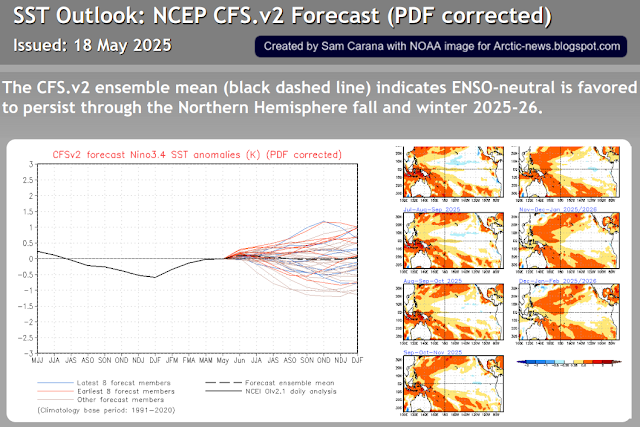 |
| [ trend points at 2°C above 1904-1913 getting crossed in 2026 ] |
Those who seek to delay or sabotage climate action typically call for use of a late base, in efforts to minimize the historic temperature rise. Using an earlier base can mean that temperatures are already higher than the thresholds that politicians at the adoption of the Paris Agreement pledged wouldn't be crossed, and it can also imply that the temperature rise is accelerating faster and further, due to stronger feedbacks such as more water vapor in the atmosphere and disappearance of lower clouds, all of which would constitute a stronger call for climate action.
The image below illustrates that air temperatures in the Northern Hemisphere have been very high over the past few months, at times reaching record high temperatures for the time of year, e.g. the temperature in the Northern Hemisphere was 10.08°C on May 14, 2025, the highest temperature on record for that day.
 |
| [ from earlier post, click on images to enlarge ] |
 |
| [ from April 2024 post, click on images to enlarge ] |
 |
| [ from a 2014 post, click on images to enlarge ] |
The image on the right, from a 2014 post, points at the fallacy and deceit that comes with a carbon budget, carbon credits, offsets and net-zero emission targets that would, according to the IPCC, accomplish and maintain a "balance" between sources and sinks.
Instead, comprehensive and effective action is needed on multiple lines of action, simultaneously yet separately.
Indeed, action is needed to reduce concentrations of carbon both in oceans and in the atmosphere, while on land, the soil carbon content needs to increase, which can best be achieved by methods such as pyrolysis of biowaste and adding the resulting biochar to the soil, to reduce emissions, reduce fire hazards, sequester carbon, support the presence of moisture & nutrients in the soil and thus support the health & growth of vegetation, as discussed at the Climate Plan group and the biochar group.
The IPCC has failed on at least three points:
1. failed to warn about the historic temperature rise and associated larger feedbacks
Higher temperatures come with feedbacks, as illustrated by the image below, from an earlier post.
 |
| [ the temperature in the atmosphere can keep rising, even in the absence of further emissions ] |
The IPCC failed to warn about Antarctic sea ice decline, and - importantly - the amplifying impact of Antarctic sea ice decline on the global temperature rise. This was addressed in an earlier post as follows:
Sea ice loss results in less sunlight getting reflected back into space and instead getting absorbed by the ocean and the impact of Antarctic sea ice loss is even stronger than Arctic sea ice loss, as Antarctic sea ice is located closer to the Equator, as pointed out by Paul Beckwith in a video in an earlier post. A warmer Southern Ocean also comes with fewer bright clouds, further reducing albedo, as discussed here and here. For decades, there still were many lower clouds over the Southern Ocean, reflecting much sunlight back into space, but these lower clouds have been decreasing over time, further speeding up the amount of sunlight getting absorbed by the water of the Southern Ocean, and this 'pattern effect' could make a huge difference globally, as this study points out. Emissivity is a further factor; open oceans are less efficient than sea ice when it comes to emitting in the far-infrared region of the spectrum (feedback #23 on the feedbacks page).
Slowing down of the Atlantic meridional overturning circulation (AMOC) can cause more heat to accumulate at the ocean surface. Higher sea surface temperatures also come with greater stratification (image below, from earlier post).
Stratification and further changes in oceans and in wind patterns can cause a freshwater lid to form on top of the ocean surface, enabling more hot & salty water to flow underneath this lid (feedback #28), contributing to calving of glaciers and destabilization of sediments at the seafloor.
One feedback of high temperatures and high concentrations of greenhouse gases is loss of sea ice. Polar amplification of the temperature rise is hitting the Arctic hard, and is also causing dramatic loss of Antarctic sea ice. Global sea ice area has been very low for the past few years, as illustrated by the image below. This has caused a lot of sunlight that was previously reflected back into space, to instead get absorbed by the sea surface. On May 24, 2025, global sea ice area was 17.75 million km², lowest on record for the day.
 |
| [ click on images to enlarge ] |
The situation is dire and the precautionary principle calls for rapid, comprehensive and effective action to reduce the damage and to improve the situation, as described in this 2022 post, where needed in combination with a Climate Emergency Declaration, as discussed at this group.
• NASA - datasets and images
https://data.giss.nasa.gov
• When Will We Die?
https://arctic-news.blogspot.com/2019/06/when-will-we-die.html
• Copernicus - Climate Pulse
https://pulse.climate.copernicus.eu
• Climate Reanalyzer
https://climatereanalyzer.org
• NOAA - Climate Prediction Center - ENSO: Recent Evolution, Current Status and Predictions
https://www.cpc.ncep.noaa.gov/products/analysis_monitoring/lanina/enso_evolution-status-fcsts-web.pdf
• NOAA - Climate Prediction Center - El Niño/Southern Oscillation (ENSO) Diagnostic Discussion
https://arctic-news.blogspot.com/p/pre-industrial.html
• Feedbacks
https://arctic-news.blogspot.com/p/feedbacks.html
• NOAA - Office of Satellite And Product Operations - Sea Surface Temperatures
https://www.ospo.noaa.gov/products/ocean/sst/contour/index.html
• Nullschool.net
https://earth.nullschool.net
• Jet Stream
https://arctic-news.blogspot.com/p/jet-stream.html
• Cold freshwater lid on North Atlantic
https://arctic-news.blogspot.com/p/cold-freshwater-lid-on-north-atlantic.html
• Danish Meteorological Institute - Arctic sea ice volume and thickness
https://ocean.dmi.dk/arctic/icethickness/thk.uk.php
• University of Bremen
https://seaice.uni-bremen.de/start
• NASA - Worldview satellite images
https://worldview.earthdata.nasa.gov
• Transforming Society
https://arctic-news.blogspot.com/2022/10/transforming-society.html
• Climate Plan
https://arctic-news.blogspot.com/p/climateplan.html
• Climate Emergency Declaration
https://arctic-news.blogspot.com/p/climate-emergency-declaration.html

















.png)





















